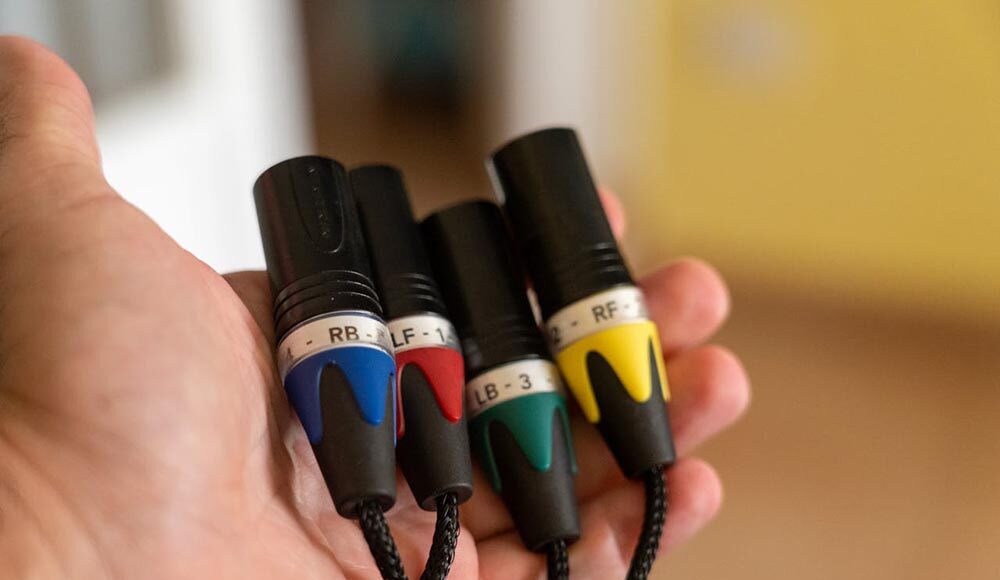Welcome to the ultimate guide to XLR microphone connectors and cables! Whether you’re setting up a professional recording studio, connecting a microphone to an audio interface, or simply aiming for superior audio quality in your home setup, understanding XLR cables and connectors is essential. This guide will provide you with a comprehensive overview, covering everything from the basic components to selecting the appropriate XLR for your specific needs.
Understanding the XLR Connector
What is an XLR Connector?
An XLR connector is a type of electrical connector primarily found on professional audio equipment. The term “XLR” technically stands for “External Line Return,” though the acronym’s origin is debated. XLR connectors are most commonly used to connect microphones to mixers, audio interfaces, preamps, and other pro audio gear. XLR cables use balanced audio signals to minimize noise and interference, ensuring a cleaner, higher-quality sound. This is crucial for recording, broadcasting, and any application where audio quality is paramount.
Components of an XLR Connector
XLR connectors usually have a circular shape with three pins. These pins are used for balanced audio transmission. The connector also has a locking mechanism, providing a secure connection to audio equipment.
| Pin Number | Function |
| Pin 1 | Ground (Shield) |
| Pin 2 | Positive Audio Signal |
| Pin 3 | Negative Audio Signal |
This balanced setup helps reduce noise, resulting in better audio quality, especially when using long cables.
Types of XLR Connectors
XLR connectors come in two main types: male XLR connectors and female XLR connectors. Male XLR connectors typically have protruding pins and are often found on microphones and output devices. Female XLR connectors have corresponding holes to receive the pins and are usually found on input devices such as audio interfaces, mixers, and preamps.
Choosing the right XLR, whether male or female, depends on the specific application and the types of connections you need to establish within your setup. High-quality XLR cables are designed for durability and optimal performance of XLR.
Choosing the Right XLR Cable
Importance of Shielding in XLR Cables
When selecting the appropriate XLR cable, the shielding is a critical factor to consider. The shield in an XLR cable is designed to protect the audio signal from external noise and interference, ensuring superior audio quality. High-quality XLR cables use a dense shield, often made of braided copper or aluminum foil, to block electromagnetic and radio frequency interference.
Without adequate shielding, your audio signal can be compromised, resulting in unwanted hums, buzzes, and other noises that can degrade your recording or live sound. Therefore, choosing the right XLR cable with robust shielding is essential for professional audio and achieving the best possible sound quality, particularly when using an XLR microphone in demanding environments.
Choosing the Right Length for Your XLR Cable
Selecting the appropriate length for your XLR cable is another crucial consideration for your setup. While it might seem convenient to use excessively long cables, doing so can increase the risk of signal degradation and interference, especially with unbalanced connections (though XLR cables use balanced audio signals, minimizing this issue).
Longer cable runs act as antennas, potentially picking up noise and diminishing the audio signal strength. Conversely, using cables that are too short can limit the placement of your audio equipment. Measure the distance between your microphone and audio interface or mixer and choose a cable that provides just enough length, allowing for some slack to prevent strain on the connectors. This ensures optimal signal transmission and sound quality with your XLR microphone.
Common Applications of XLR Cables
XLR cables and connectors find widespread applications in various audio settings. In professional recording studios, XLR cables are used to connect microphones to preamps, audio interfaces, and mixing consoles. In live sound environments, they connect microphones to mixers and PA systems, ensuring high-quality audio for performances.
Broadcasting relies heavily on XLR cables for connecting microphones to broadcast consoles, delivering clear and reliable audio for radio and television. Additionally, XLR connectors are used in some high-end home audio setups for connecting balanced audio equipment, providing superior audio quality compared to RCA connectors or TRS cables.
Understanding these common applications helps in selecting the appropriate XLR cable for your specific needs, guaranteeing optimal performance of XLR and durability in any audio setup.
Using XLR Microphones
Setting Up Your XLR Microphone
Setting up your XLR microphone correctly is crucial for achieving optimal audio quality and minimizing noise and interference. Begin by connecting the XLR cable to your microphone, ensuring that the locking mechanism is properly engaged to secure the connection. Then, plug the other end of the XLR cable into your audio interface, mixer, or preamp. It’s essential to use balanced audio connections to fully leverage the noise-canceling capabilities of XLR cables. Double-check that your audio equipment is powered on and that the input gain is appropriately adjusted to capture a clean audio signal. A well-executed setup ensures that your XLR microphone performs at its best, providing you with high-quality recordings or live sound.
Microphone Connections and Compatibility
Understanding microphone connections and compatibility is vital when working with XLR connectors and cables. XLR connectors are the standard for professional audio equipment due to their ability to transmit balanced audio signals, which significantly reduces noise and interference. When connecting your XLR microphone to various audio interfaces or mixers, ensure that the device supports XLR inputs and provides phantom power if your microphone requires it. Some audio interfaces might offer combo jacks that accept both XLR and TRS connectors, providing flexibility. Always consult the user manuals for your microphone and audio equipment to confirm compatibility and ensure proper configuration of balanced audio connections.
Benefits of Using XLR Microphones
The benefits of using XLR microphones are numerous, particularly in scenarios demanding superior audio quality. One of the primary advantages is their ability to transmit balanced audio, which minimizes noise and interference, resulting in cleaner and more professional recordings. XLR microphones are also incredibly durable, making them suitable for the rigors of both studio and live performance environments.
The locking mechanism on XLR connectors ensures a secure connection, preventing accidental disconnections during critical moments. Furthermore, choosing the right XLR microphone and XLR cables are designed to offer a higher degree of signal integrity compared to alternatives like RCA connectors, making them the preferred choice for broadcasting and professional audio applications. Knowing about XLR’s applications enhances your audio setup.
Balanced Audio and Signal Integrity
What is Balanced Audio?
Balanced audio is a method of interconnecting audio equipment using three-conductor cables and connectors, such as XLR connectors, to minimize noise and interference. In a balanced audio setup, the audio signal is split into two identical but opposite polarity signals.
These signals travel along two of the three pins in the XLR connector, while the third pin is connected to ground, providing a shield. This balanced audio transmission helps cancel out common-mode noise picked up along the cable, resulting in superior audio quality. This technique is crucial for achieving high-quality recordings and broadcasting in professional audio environments.
Importance of Balanced Audio Signals
The importance of balanced audio signals cannot be overstated, especially when dealing with longer cable runs or environments prone to noise and interference.
Using XLR connectors and cables to transmit balanced audio ensures that any noise picked up along the cable affects both signal conductors equally. When these signals reach the receiving end, the differential amplifier in the audio equipment inverts one signal and combines it with the other, effectively canceling out the common-mode noise while reinforcing the desired audio signal.
This results in a cleaner, clearer audio signal, making balanced audio essential for professional audio applications and achieving optimal sound quality. It is important to select the appropriate XLR for use.
How XLR Cables Maintain Signal Integrity
XLR cables play a crucial role in maintaining signal integrity through several design features. The use of balanced audio transmission is paramount, as it cancels out common-mode noise. Additionally, the shield in the XLR cable protects the audio signal from external electromagnetic interference.
High-quality XLR cables employ a dense shield, often made of braided copper, to maximize this protection. The XLR connector’s locking mechanism ensures a secure connection, preventing accidental disconnections that could disrupt the audio signal. By combining balanced audio with robust shielding and secure connections, XLR cables are designed to provide superior audio quality and reliable performance of XLR in various audio applications.
Maintaining and Troubleshooting XLR Connections
Common Issues with XLR Cables and Connectors
Several common issues can arise with XLR cables and connectors, impacting audio quality and signal integrity. One frequent problem is a loose or corroded pin within the XLR connector, which can cause intermittent signal loss or noise. Another issue is damage to the XLR cable shield, which reduces its ability to protect against noise and interference.
Additionally, wear and tear on the locking mechanism can lead to unreliable connections, resulting in dropouts or signal degradation. Regularly inspecting your XLR cables and connectors for these issues and taking appropriate maintenance steps is essential for ensuring consistent, high-quality audio performance in pro audio equipment and microphone connections. Choosing the right XLR is important for avoiding these issues.
Tips for Maintaining Your XLR Setup
To maintain your XLR setup and ensure the longevity and optimal performance of XLR cables and connectors, several practices should be followed. Regularly inspect the XLR connectors for bent or damaged pins, and clean them with a contact cleaner to remove any corrosion. Avoid pulling on the XLR cable itself when disconnecting; instead, grip the connector body.
When storing XLR cables, coil them loosely to prevent kinking and internal damage. Use cable testers to verify the integrity of the XLR cable and its connections. These simple maintenance steps will help prevent common issues and extend the life of your XLR setup ensuring high-quality sound and that balanced audio signals are transmitted properly.
When to Replace Your XLR Cables
Knowing when to replace your XLR cables is crucial for maintaining superior audio quality and avoiding potential failures during critical recording or live sound situations. If you notice persistent noise, crackling, or signal dropouts that cannot be resolved through cleaning or basic troubleshooting, it may be time to replace the XLR cable.
Physical damage to the XLR cable shield or connector, such as cuts, fraying, or a broken locking mechanism, also warrants replacement. In addition, it might be time to consider replacing your XLR cables if they are old or of low-quality, with high-quality XLR cables designed to enhance your recording. By choosing the right XLR for your needs you can avoid replacing cables frequently. Selecting the appropriate XLR can ensure your audio setup.
##





